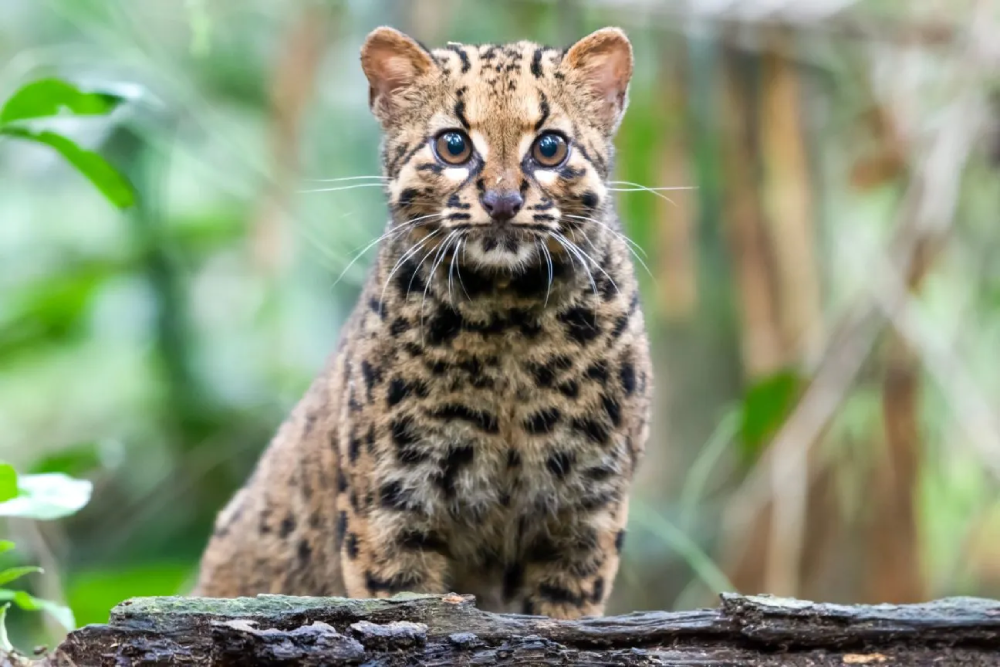Hidden within the dense foliage of the Southeast Asian rainforests, among the misty canopies and tangled undergrowth, lurks a creature that seems plucked from the realms of myth and fantasy. The marbled cat (*Pardofelis marmorata*) is a small, elusive felid that roams the forests of the eastern Himalayas, Southeast Asia, and the islands of Borneo and Sumatra. With its striking coat pattern and secretive nature, the marbled cat remains one of the least understood cats in the world.
Appearance and Characteristics
The marbled cat is a marvel of natural design, with a unique coat pattern that sets it apart from its larger feline relatives. Its name, “marbled,” aptly describes the intricate swirls and blotches that adorn its fur, resembling the intricate patterns of marble stone. This cryptic coloration serves as camouflage among the dappled sunlight and shadows of the forest floor, allowing the cat to blend seamlessly into its surroundings.
Despite its small size, the marbled cat possesses a lithe and muscular build, adapted for stealth and agility in its arboreal habitat. Its large, expressive eyes are set in a rounded face, giving it an appearance that is both endearing and enigmatic. Unlike many other cats, the marbled cat has relatively short legs and a long, bushy tail, which aids in balance as it navigates the branches high above the forest floor.

Habitat and Range
The marbled cat is primarily found in the dense tropical rainforests of Southeast Asia, including the Himalayan foothills, Myanmar, Thailand, Malaysia, and the islands of Borneo and Sumatra. Within these lush and biodiverse habitats, the cat prowls through a variety of ecosystems, from lowland jungles to montane forests at elevations of up to 3,000 meters (9,800 feet).
This cat is highly adaptable and can thrive in a range of environments, from primary rainforests to disturbed habitats near human settlements. However, its secretive nature and elusive behavior make it challenging to study and monitor in the wild, leading to gaps in our understanding of its distribution and population dynamics.
Behavior and Ecology
Much of what we know about the marbled cat’s behavior comes from scattered observations and occasional encounters with researchers and local inhabitants. Unlike its larger cousins, such as tigers and leopards, the marbled cat is primarily arboreal, spending much of its time high in the forest canopy. It is an adept climber and jumper, using its powerful limbs and sharp claws to navigate the treetops with ease.
The marbled cat is primarily a solitary creature, with individuals coming together only during the breeding season. They are primarily nocturnal or crepuscular, hunting under the cover of darkness for its preferred prey, which includes small mammals, birds, reptiles, and insects. Its keen senses of sight and hearing help it locate prey in the dim light of the forest, while its retractable claws and sharp teeth make it a formidable hunter.
Conservation Status and Threats
Despite its elusive nature, the marbled cat is not immune to the threats facing many of the world’s wild felines. Habitat loss and fragmentation due to deforestation, agricultural expansion, and human development pose significant challenges to the long-term survival of this species. As forests are cleared and fragmented, the marbled cat’s range becomes increasingly isolated, making it more vulnerable to extinction.
In addition to habitat loss, the marbled cat faces threats from poaching and illegal trade. Its striking coat pattern makes it a target for poachers seeking to profit from the exotic pet trade or the sale of its pelts. Furthermore, the depletion of prey species due to hunting and habitat degradation further exacerbates the challenges facing this elusive predator.
Conservation Efforts
Efforts to conserve the marbled cat and its habitat are underway, but much work remains to be done to ensure its survival. Conservation organizations and government agencies are working to establish protected areas and wildlife corridors to safeguard critical habitat for the species. Research efforts aimed at better understanding the marbled cat’s ecology, behavior, and population dynamics are also underway, helping to inform conservation strategies and management decisions.
Community-based conservation initiatives, which involve local communities in the protection and management of natural resources, are proving to be effective in some areas. By providing alternative livelihoods and incentives for conservation, these initiatives help reduce human-wildlife conflicts and promote sustainable coexistence between people and wildlife.
Conclusion
The marbled cat remains a mystery of the Asian rainforests, a secretive and enigmatic creature that continues to fascinate researchers and wildlife enthusiasts alike. Its unique appearance, elusive behavior, and importance as a top predator highlight the importance of conserving the rich biodiversity of Southeast Asia’s forests.
As we strive to protect the marbled cat and its habitat, we must also recognize the interconnectedness of all living things and the importance of preserving the delicate balance of nature. By working together to conserve the forests and wildlife of Southeast Asia, we can ensure a brighter future for the marbled cat and countless other species that call these forests home.









